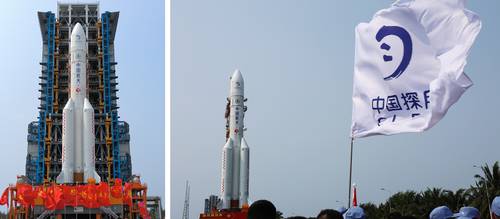
▲ In the pictures the missile Yao-8It is the largest in the Asian country and transports the space probe.Image taken from CNSA portal
Daniel Gonzalez Delgadillo
sender
La Jornada newspaper
Saturday, May 4, 2024, p. 6
Beijing. Space probe Chang’e-6 It was successfully launched yesterday to collect and return samples from the little-explored far side of the moon, the China National Space Administration (CNSA) said, a new operation that is part of a government program that aims to send a manned mission to Earth’s natural satellite. By 2030.
he Yao-8The Long March-5 carrier rocket, China’s largest, lifted off at 5:27 p.m. local time from the Wenchang Space Launch Center on the southern island of Hainan. Chang’e-6The agency said in a statement that its weight exceeds eight metric tons, and after 37 minutes it entered directly into the transition orbit between the Earth and the Moon.
The probe consists of an orbiter, a reentry vehicle, a lander, and an ascender vehicle. He pointed out that it supports measurement and control on the ground and satellite for data transmission QUIQIAO-2It was launched and placed in orbit at the end of last March as part of this lunar project.
The space agency said that the area chosen for landing and sampling is the South Pole-Aitken Basin on the far side of the moon. According to the plan, it will undergo operations such as transition between the Earth and the Moon, braking near the natural satellite, putting it into orbit and landing, as well as a soft landing on the surface to finally arrive at a pre-determined area on the hidden side.
Among its main goals are to collect rock and soil samples from the lunar surface and conduct scientific exploration. After completing the sampling and packaging, the probe will launch from the surface of the Moon, then rendezvous and dock in the lunar orbit, and transfer the samples to the returner, which will undergo operations such as transportation from the Moon to Earth.
The entire process from launch to return of mission samples Chang’e-6 The CNSA said it lasts about 53 days. The mission cycle is long, there are many engineering innovations, high risks and difficulties, and each stage is interconnected
.
The New China News Agency (Xinhua) described the launch as… The first attempt of its kind in the history of lunar exploration
.
Scientists believe the far side of the Moon, so named because it cannot be seen at all from Earth, even though it receives light from the Sun, is promising because its craters are not covered by ancient lava flows.
compared to the task Chang’e-5Which achieved the return of a sample from the far side of the Moon in 2020, and the latest mission requires the implementation of the first sample return from the far side of the Moon with the support of… QUIQIAO-2.
At the same time, this mission will carry out scientific explorations, such as research and analysis On site The landing zone on the back of the Moon, laboratory analysis and search for lunar samples, and will deepen the study of the history of the formation and evolution of the Moon.
The Asian giant has made remarkable progress in space matters after leaving the International Space Station: building its own Tiangong station, landing robotic vehicles on Mars, and is the third country to take astronauts into space, which last week sent a new vehicle. A trio of astronauts.
By 2030, it wants to send a manned mission to the moon and also plans to build a base on Earth’s satellite.
Chang’e-6 This is only the first of three unmanned missions to the moon that China plans this decade. behind him, Chang’e-7will explore the moon’s south pole in search of water, and Chang’e-8 We will try to determine the technical feasibility of building a base there, the basic model of which is scheduled to be completed by that year.

“Social media evangelist. Student. Reader. Troublemaker. Typical introvert.”

:quality(85)/cloudfront-us-east-1.images.arcpublishing.com/infobae/TEQF6EONZRFGLLLDIDD4L2O4EE.jpg)

:quality(75)/cloudfront-us-east-1.images.arcpublishing.com/elcomercio/XU32LRAEZFDDPNVHLFU3CKVBYY.jpg)


More Stories
Venezuela ranks fourth in female leadership in science and technology in Latin America
In Portuguesa and Sucre they explore the wonderful world of science
The university court overturns the expulsion of two teachers and a chemical sciences student